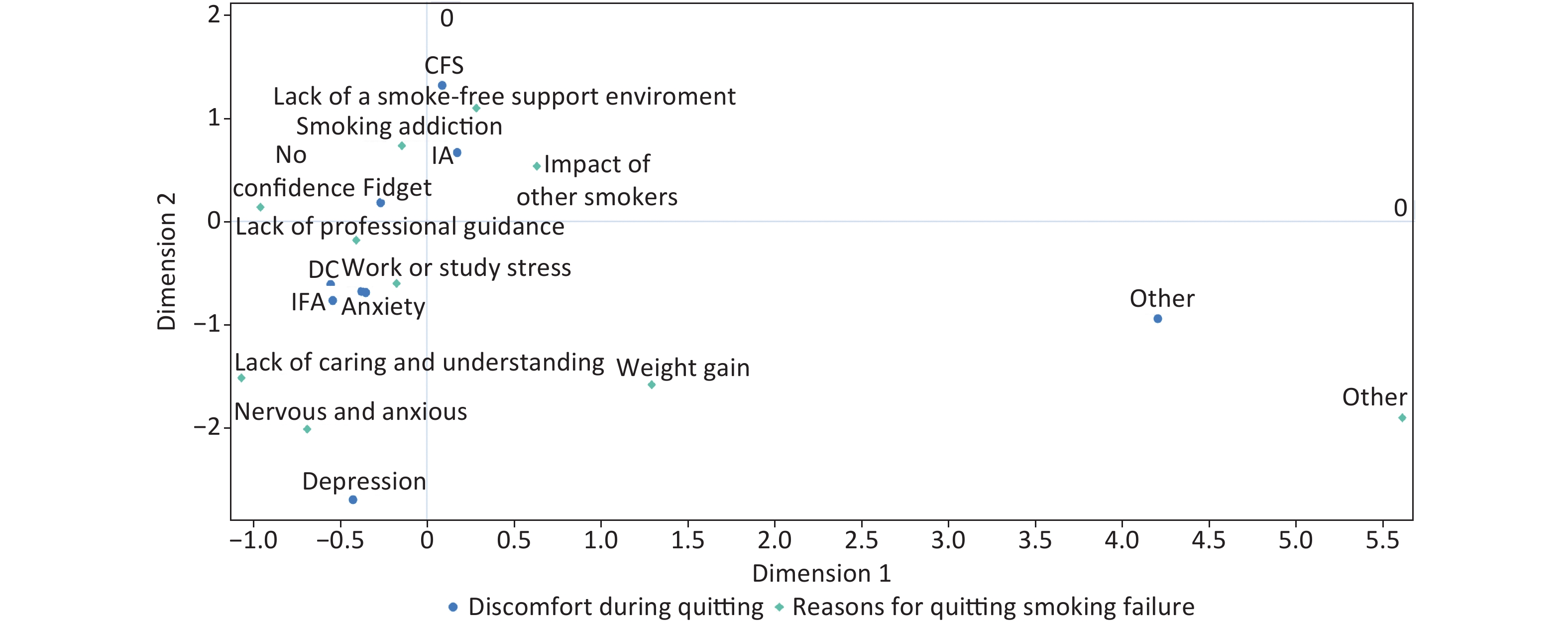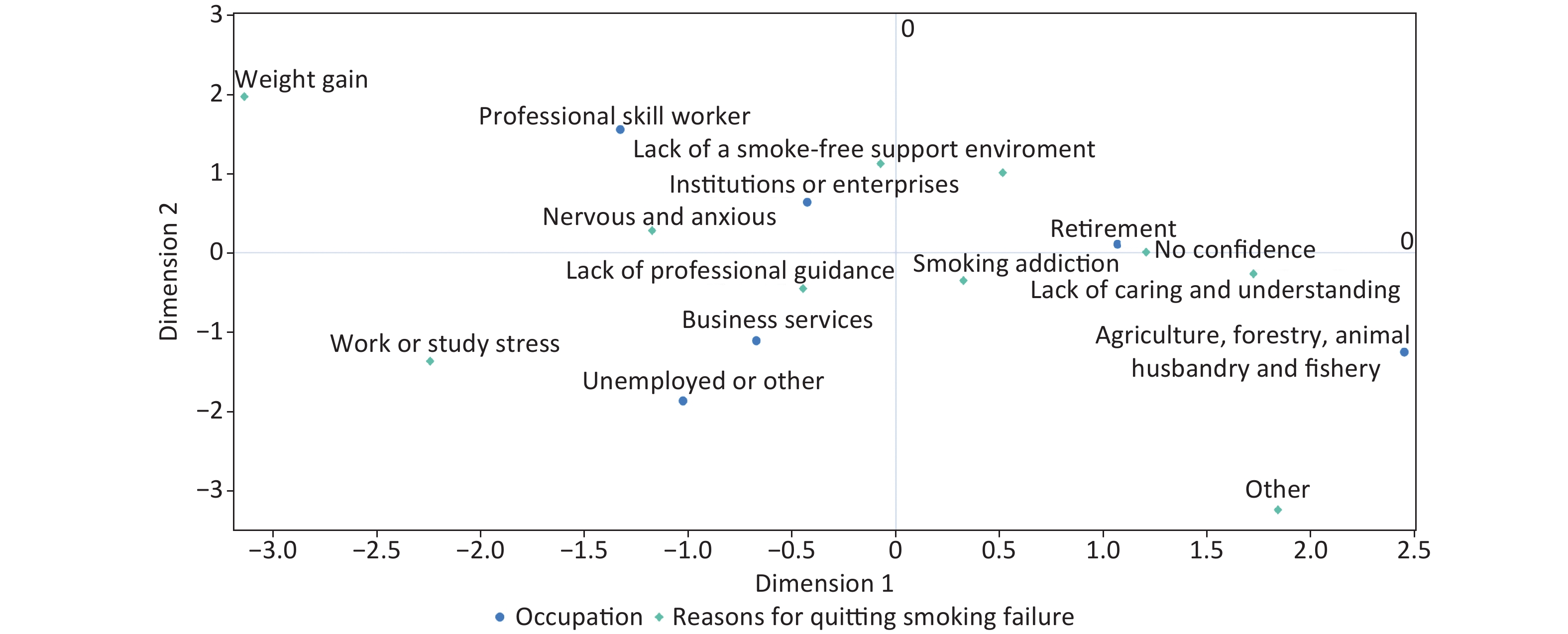-
With the implementation of tobacco control policies and increasing publicity year by year, smokers have acquired more information and knowledge through various channels about the harmful effects of smoking. As a result, more smokers have developed a desire to quit smoking and have begun to try to quit. But quitting smoking is a complicated process with a high failure rate. “2018 China Adult Tobacco Survey Results” showed that public awareness of the dangers of smoking was increased however, the rate of smoking cessation among adults did not show any significant changes. The smoking cessation rate among people aged 15 and over in China is 20.1%, and that among daily smokers is only 15.6%[1]. Many smokers have tried to quit smoking multiple times but eventually relapsed due to various reasons such as social stress or cravings for smoking. It is important to understand the reasons that affect smokers’ failure to quit, which will help them in providing more targeted quit guidance services in the future.
Previous studies have focused on the average smoker’s attempts to quit, but there has been a lack of research on smokers who have a clear intention to quit. The studies have suggested that 16.1% of smokers plan to quit smoking in the next 12 months[1]. This means that there is currently a demand for smoking cessation services. But how to help smokers quit more effectively and improve the success rate of quitting? This study intends to analyze the reasons for the failure of smoking cessation and the influencing factors for smokers who have tried to quit smoking in various communities in Beijing. We aim to discover whether there are differences in the reasons for smoking cessation failure among different groups of people. This will generate a theoretical basis for providing scientific and effective smoking cessation strategies.
This research is based on the National Key R&D Program of China. The survey was conducted by a cross-sectional epidemiological study from December 2018 to December 2019. The recruitment was conducted through 19 various community health service centers in Beijing using a convenient sampling method, and face-to-face interview by trained investigators was used to obtain the data. The inclusion criteria of the study subjects were: 1) 18 years old and above; 2) smokers who are residents in the community and participate in community smoking cessation programs; 3) fluent in language communication and willing to be surveyed.
The exclusion criteria were: 1) under 18 years of age; 2) non-smokers; 3) inability to communicate smoothly; 4) unwilling to be investigated. A total of 692 subjects were included in the study, of which 442 were those who had tried to quit smoking.
The content of the questionnaire survey includes (1) demographic information: gender, age, education, marital status, occupation, monthly income of the respondents; (2) tobacco use: smoking age, age at which smoking started, Nicotine Dependence Assessment Scale (FTND)[2], tobacco consumption; (3) attempting to quit smoking (it refers to quitting for 24 hours voluntarily for long-term cessation )[3]: the number of attempts to quit, the duration of attempts to quit, the methods and methods of failure, the reasons for failure.
In the Nicotine Dependence Assessment Scale (FTND), the total of six questions is 1–3 points for mild dependence, 4–6 points for moderate dependence, 7–10 points for severe dependence[2].
The database is double input and managed with Epidata v3.1 (designed by Jens M.Lauritsen & Michael Bruus and released by The EpiData Association, Odense Denmark), and SPSS 22.0 produced by IBM (International Business Machines Corporation, USA) is imported for data analysis. Descriptive analysis was used to count the basic information of the survey participants, their behaviors of quitting smoking attempts, and the reasons for their failure; Chi-square test and Fisher exact probability method were used to analyze the relationship between the reasons for the failure of smoking cessation of the study subjects and their demographic indicators, daily smoking, nicotine dependence, and discomfort during smoking cessation; Correspondence Analysis was used to analyze statistically significant indicators to explore their relationship with smokers’ failure to quit. The statistically significant difference was set at P < 0.05.
The Medical Ethics Committee has approved this study of Capital Medical University (Z2019SY007), and informed consent was obtained from the subjects before the investigation. In addition, this study has been registered on the official website of the China Clinical Trial Registration Center (ChiCTR1900024991).
In this analysis, 442 community smokers who had tried to quit smoking were selected as the research subjects. Among them, the majority were men (n = 407, 92.1%), and the highest proportion was at the age of 60 years and above (n = 174, 39.4%); from the marital status, the majority were married (n = 393, 88.9%); the majority of them are college graduates or above (n = 186, 42.7%); most of the respondents have retired (n = 189, 42.8%), as seen in Supplementary Table S1, available in www.besjournal.com.
Demographic indicators Male (n = 407) Female (n = 35) χ2 P Frequency Percentage (%) Frequency Percentage (%) Age (years) 19− 13 3.2 0 0 3.915 0.271 30− 78 19.3 3 8.6 45− 156 38.5 16 45.7 ≥ 60 158 39.0 16 45.7 Marital status unmarried 20 4.9 1 2.9 7.320 0.120 married 364 89.7 29 82.9 separation 3 0.7 0 0.0 divorced 11 2.7 1 2.9 widowed 8 2.0 4 11.4 Educational level elementary and below 23 5.7 5 14.3 9.729 0.021 junior high school 103 25.3 11 31.4 high school/secondary school 102 25.1 12 34.3 college and above 179 44.0 7 20.0 Occupation agriculture, forestry, animal husbandry and fishery 8 2.0 0 0.0 12.818 0.025 business services 52 12.9 2 6.1 professional skill worker 47 11.6 2 6.1 institutions or enterprises 74 18.3 3 9.1 retirement 165 40.8 24 72.7 unemployed or other 58 14.4 2 6.1 Age (years) at which smoking is started 7− 9 2.3 0 0.0 46.062 < 0.001 10− 289 72.8 10 29.4 20− 94 23.7 19 55.9 30− 5 1.3 5 14.7 Smoking age (years) 2− 30 7.7 3 9.4 5.697 0.127 10− 149 38.2 17 53.1 30− 192 49.2 9 28.1 50− 19 4.9 3 9.4 Nicotine Dependence Assessment Scale mild 137 33.7 13 37.1 0.331 0.847 moderately 195 47.9 15 42.9 heavy 75 18.4 7 20.0 Quit smoking attempts (times) 1 136 33.9 14 40.0 3.784 0.993 2 124 30.9 9 25.7 3 82 20.4 6 17.1 4 12 3.0 1 2.9 5− 27 6.7 3 8.6 ≥ 10 20 4.9 2 5.7 Time to stop smoking when you last tried to quit less than 1 day 26 6.6 1 2.9 3.901 0.420 1–7 days 107 27.3 7 20.0 8–10 days 79 20.2 5 14.3 more than a month 101 25.8 12 34.3 more than half a year 79 20.2 10 28.6 Table S1. Demographic information distribution of smokers in Beijing communities (n = 442)
Quit smoking attempt refers to the behavior of smokers to quit smoking. An analysis of past smoking cessation attempts of smokers shows that 156 smokers have tried to quit smoking once, accounting for 35.3%, and 133 people said they had tried to quit smoking twice, accounting for 30.1%. Most smokers try to quit three times or less, and a few smokers report that they have tried to quit more often. For example, 30 smokers said they had tried five or more times and less than ten attempts to quit, and 22 said they had tried ten or more times, but all failed in permanent cessation of smoking. The smokers reported the duration that they have last tried to quit smoking, 45.7% of them stopped smoking for more than one month, some even maintained a non-smoking state for no more than half a year. In additon, 29.2% of the respondents stopped smoking for one week and then re-smoked.
Smokers made many attempts to quit smoking and stopped smoking temporarily for a while, but they all ended in failure. This reminds us that quitting smoking is a process with a high failure rate, and therefore, we need to investigate it further. What is the reason for failure to quit smoking? How to avoid the reasons for failure to quit smoking, find suitable smoking cessation methods and techniques, and help those who are willing to quit smoking quit successfully?
Further analysis shows that 240 smokers attributed the failure to quit smoking to the difficulty of controlling addiction and insufficient willpower, accounting for 54.3% of the total respondents, as seen in Supplementary Table S2, available in www.besjournal.com. In addition, 35.3% of the respondents believed that the influence of other smokers was an important reason for their failure to quit smoking. While 26.0% of the respondents felt that the lack of a smoke-free support environment is an important influencing factor. Studies have shown that in the case of peer smoking, due to the induction of visual cues[4], there will be an intense craving for cigarettes, and they tend to continue smoking and give up their intention to quit smoking, thus failing to quit. Among them, young smokers are eager to gain recognition through behaviors consistent with the group due to their psychological effects[5]. Therefore, smoking cessation behavior may be more affected by other smokers. This reminds us that social needs influence smokers’ smoking cessation behavior to a large extent. When guiding quitting smoking can help correct smokers’ cognitive attitudes toward social smoking behavior and provide them with coping with smoking cessation in social situations and tips for relieving peer pressure[6]. In addition, the government and various departments should further support the shaping of a smoke-free environment.
Reasons for quitting smoking failure Frequency Percentage (%) Smoking addiction is difficult to restrain and self-willpower is insufficient 240 54.3 Lack of professional guidance 90 20.4 Lack of caring and understanding 18 4.1 Lack of a smoke-free support environment 115 26.0 No confidence 53 12.0 Nervous and anxious 70 15.8 Weight gain 9 2.0 Work or study stress 68 15.4 Impact of other smokers 156 35.3 Other 31 7.0 Table S2. Reasons for failure of community smokers in Beijing to try to quit smoking (multiple choices, n = 442)
Univariate analysis of reasons why smokers fail to quit smoking showed that the differences in the distribution of the reasons for the failure of smokers to quit smoking were different in various ages, occupations, and discomforts during quitting (All P < 0.05). There was no statistical difference in the distribution of gender, marital status, education level, average daily smoking, and nicotine dependence (All P > 0.05), as seen in Supplementary Tables S3–S4, available in www.besjournal.com. Among the different age groups, the top three reasons for the failure of smoking cessation among 19–30 years old smokers are the difficulty of restraint of addiction, insufficient self-willing, the stress of work or study, and the influence of other smokers. The top three causes of smoking cessation failure among smokers aged 30–45, 45–60, and 60 and above are those who have difficulty controlling addiction, lack of self-will, the influence of other smokers, and lack of smoke-free support surroundings.
Index Grade Smoking addiction is difficult to restrain and self-willpower is insufficient Lack of professional guidance Lack of caring and understanding Lack of a smoke-free support environment No confidence Nervous and anxious Weight gain Work or study stress Impact of other smokers Other χ2 p Frequency Percentage
(%)Frequency Percentage
(%)Frequency Percentage
(%)Frequency Percentage
(%)Frequency Percentage
(%)Frequency Percentage
(%)Frequency Percentage
(%)Frequency Percentage
(%)Frequency Percentage
(%)Frequency Percentage
(%)Sex Male 224 28.5 85 10.8 18 2.3 106 13.5 51 6.5 63 8.0 9 1.1 63 8.0 135 17.2 31 3.9 12.021 0.170 Female 16 24.6 5 7.7 0 0.0 9 13.8 2 3.1 7 10.8 0 0.0 5 7.7 21 32.3 0 0.0 Age (years) 19− 7 28.0 1 4.0 0 0.0 2 8.0 0 0.0 2 8.0 0 0.0 7 28.0 6 24.0 0 0.0 123.1 < 0.001* 30− 44 22.3 21 10.7 2 1.0 33 16.8 13 6.6 23 11.7 3 1.5 26 13.2 31 15.7 1 0.5 45− 88 28.4 36 11.6 8 2.6 37 11.9 19 6.1 23 7.4 4 1.3 20 6.5 62 20.0 13 4.2 ≥ 60 100 31.9 32 10.2 8 2.6 42 13.4 21 6.7 21 6.7 2 0.6 14 4.5 56 17.9 17 5.4 Marital status Unmarried 9 21.4 6 14.3 0 0.0 3 7.1 3 7.1 4 9.5 0 0.0 11 26.2 6 14.3 0 0.0 31.380 0.513 Married 215 28.4 82 10.8 18 2.4 106 14.0 47 6.2 60 7.9 8 1.1 54 7.1 140 18.5 28 3.7 Separation 3 50.0 0 0.0 0 0.0 1 16.7 1 16.7 0 0.0 0 0.0 0 0.0 1 16.7 0 0.0 Divorced 7 30.4 2 8.7 0 0.0 3 13.0 0 0.0 3 13.0 0 0.0 2 8.7 4 17.4 2 8.7 Widowed 5 29.4 0 0.0 0 0.0 2 11.8 1 5.9 3 17.6 0 0.0 1 5.9 4 23.5 1 5.9 Education Elementary and below 12 25.0 5 10.4 1 2.1 7 14.6 3 6.3 3 6.3 0 0.0 5 10.4 10 20.8 2 4.2 32.439 0.170 Junior high school 58 29.6 21 10.7 5 2.6 23 11.7 11 5.6 13 6.6 2 1.0 8 4.1 44 22.4 11 5.6 High school/secondary school 63 29.6 27 12.7 1 0.5 29 13.6 14 6.6 15 7.0 3 1.4 11 5.2 39 18.3 11 5.2 College and above 107 27.2 37 9.4 11 2.8 56 14.2 25 6.4 39 9.9 4 1.0 44 11.2 63 16.0 7 1.8 Occupation Agriculture, forestry, animal husbandry and fishery 4 30.8 0 0.0 0 0.0 1 7.7 3 23.1 0 0.0 0 0.0 1 7.7 3 23.1 1 7.7 58.287 0.042** Business services 28 27.7 16 15.8 1 1.0 12 11.9 6 5.9 8 7.9 0 0.0 12 11.9 15 14.9 3 3.0 Professional skill worker 28 25.5 10 9.1 0 0.0 18 16.4 5 4.5 13 11.8 2 1.8 12 10.9 22 20.0 0 0.0 Institutions or enterprises 44 24.9 20 11.3 5 2.8 26 14.7 12 6.8 14 7.9 4 2.3 16 9.0 32 18.1 4 2.3 Retirement 103 30.4 33 9.7 10 2.9 47 13.9 23 6.8 23 6.8 1 0.3 13 3.8 69 20.4 17 5.0 Unemployed or other 30 29.1 10 9.7 2 1.9 11 10.7 4 3.9 11 10.7 2 1.9 14 13.6 13 12.6 6 5.8 Note. *:Pairwise comparison results suggest that there is a difference between 30– and 60–, and there is a difference between 45– and 60–, and there is no difference between other groups. **:Pairwise comparison results suggest that there are differences between the retirement group and the business service group, unemployed or other working groups, and no difference between the other groups. Table S3. Distribution of reasons for the failure of smoking cessation among Beijing community smokers in different demographic indicators
Index Grade Smoking addiction is difficult to restrain and self-willpower is insufficient Lack of professional guidance Lack of caring and understanding Lack of a smoke-free support environment No confidence Nervous and anxious Weight gain Work or study stress Impact of other smokers Other χ2 p Frequency Percentage
(%)Frequency Percentage
(%)Frequency Percentage
(%)Frequency Percentage
(%)Frequency Percentage
(%)Frequency Percentage
(%)Frequency Percentage
(%)Frequency Percentage
(%)Frequency Percentage
(%)Frequency Percentage
(%)Average daily smoking (count) < 10 23 21.3 8 7.4 4 3.7 13 12.0 6 5.6 10 9.3 0 0.0 13 12.0 24 22.2 7 6.5 49.719 0.186 10− 81 28.5 27 9.5 6 2.1 47 16.5 15 5.3 27 9.5 4 1.4 23 8.1 46 16.2 8 2.8 20− 97 30.6 39 12.3 3 0.9 42 13.2 22 6.9 18 5.7 2 0.6 23 7.3 59 18.6 12 3.8 30− 14 24.6 8 14.0 2 3.5 3 5.3 6 10.5 7 12.3 0 0.0 2 3.5 11 19.3 4 7.0 40− 14 29.2 7 14.6 1 2.1 3 6.3 3 6.3 5 10.4 1 2.1 5 10.4 9 18.8 0 0.0 ≥ 50 3 27.3 1 9.1 2 18.2 2 18.2 1 9.1 0 0.0 0 0.0 1 9.1 1 9.1 0 0.0 Nicotine dependence Mild 71 25.0 19 6.7 6 2.1 44 15.5 12 4.2 25 8.8 2 0.7 28 9.9 63 22.2 14 4.9 23.349 0.182 Moderate 94 30.2 33 10.6 7 2.3 42 13.5 16 5.1 26 8.4 3 1.0 24 7.7 54 17.4 12 3.9 Severe 50 28.4 28 15.9 4 2.3 21 11.9 16 9.1 12 6.8 1 0.6 13 7.4 27 15.3 4 2.3 Discomfort during quitting Craving for smoking 160 30.5 65 12.4 12 2.3 63 12.0 36 6.9 41 7.8 5 1.0 45 8.6 86 16.4 11 2.1 111.279 0.002* Anxiety 84 26.3 41 12.9 10 3.1 33 10.3 21 6.6 46 14.4 4 1.3 27 8.5 48 15.0 5 1.6 Depression 19 25.0 10 13.2 3 3.9 4 5.3 5 6.6 13 17.1 1 1.3 10 13.2 9 11.8 2 2.6 Fidget 94 27.4 44 12.8 11 3.2 40 11.7 28 8.2 38 11.1 5 1.5 27 7.9 50 14.6 6 1.7 Irritable, frustrated or angry 37 25.5 19 13.1 4 2.8 14 9.7 9 6.2 21 14.5 3 2.1 14 9.7 23 15.9 1 0.7 Difficulty concentrating 59 24.6 34 14.2 11 4.6 29 12.1 20 8.3 28 11.7 3 1.3 25 10.4 27 11.3 4 1.7 Sleep disorder 27 25.7 13 12.4 6 5.7 11 10.5 7 6.7 13 12.4 1 1.0 9 8.6 16 15.2 2 1.9 Increased appetite 33 24.1 14 10.2 4 2.9 24 17.5 4 2.9 15 10.9 2 1.5 15 10.9 24 17.5 2 1.5 Other 22 22.0 9 9.0 1 1.0 13 13.0 2 2.0 7 7.0 3 3.0 8 8.0 22 22.0 13 13.0 Note. *Pairwise comparison results indicate that there is no difference between other discomfort feelings in the process of quitting smoking and depression and sleep disorders, and there are statistical differences with the other six types of discomfort feelings. Table S4. The distribution of the reasons for the failure of smoking cessation among community smokers in Beijing among smoking behaviors and the discomfort caused by different smoking cessation processes
Among the people in different occupations, the top three reasons for failure to quit smoking are difficult to control, lack of self-will, and the influence of other smokers. In addition, smokers in agriculture, forestry, animal husbandry, and fisheries have no confidence in quitting smoking. The reason for the failure of professional skill workers is the lack of professional guidance on quitting. Finally, the inability of smokers who are unemployed or in other industries is work or study stress, which reminds us that there may be differences in the life or work pressure and motivation of smoking among smokers of different ages and working conditions, which affects their smoking cessation effects.
In addition, the withdrawal symptoms corresponding to different reasons for failure to quit smoking are also different. For example, smokers lack professional guidance in the process of quitting and may be prone to symptoms such as restlessness, difficulty concentrating, and sleep disturbances; Smokers tend to feel irritable, frustrated, or angry, causing sleep disturbances; in the absence of a smoke-free support environment, smokers find it difficult to concentrate. Therefore, while guiding quitting smoking in the future, we can provide more targeted tips to alleviate different withdrawal symptoms to help quitters overcome the difficulties of quitting smoking.
In the correspondence analysis results, the closer the distance between the scattered points, the more pronounced the tendency of the two. Correspondence analysis results showed that smokers aged 19–30 years failed to quit smoking because of work or study stress, as seen in Figures 1 and 2. During quitting smoking, it was easy to cause discomforts such as difficulty in concentration, irritability, frustration or anger, and sleep disorders. Smokers in this age group may be at the beginning or rising stages of their careers and face greater work intensity and work pressure, prone to negative emotions. Studies have shown that negative psychology, such as anxiety, affects relapse after smoking cessation[7-9]. The negative psychology of smokers can increase smokers’ craving for tobacco, and they expect to obtain sedation through tobacco to help relieve negative emotions [10]. This reminds us that for those who quit smoking at this age when providing smoking cessation services, we can increase guidance on stress response and emotional relief to help them adjust their status to successfully quit smoking.
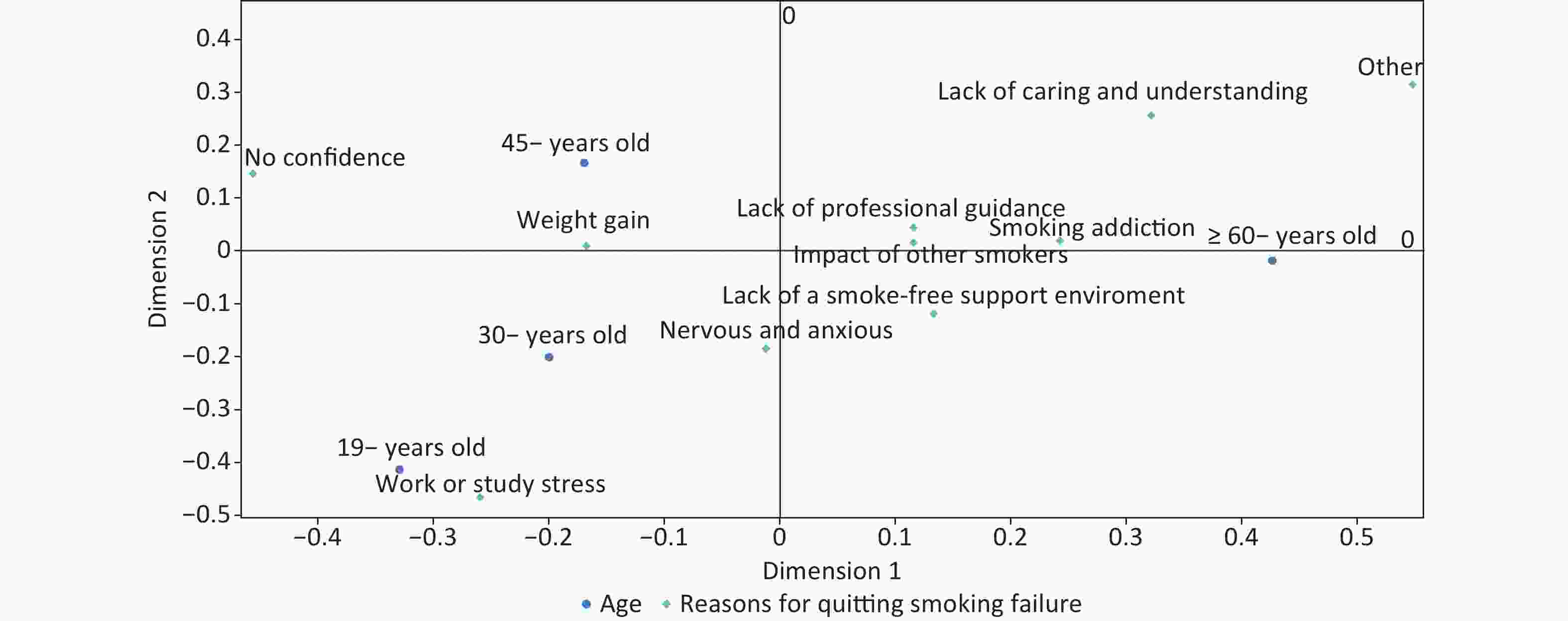
Figure 1. The relationship between failure reasons and age of smokers in Beijing communities. Smoking addiction refers to difficulty to control the onset of smoking addiction, insufficient self-willing.
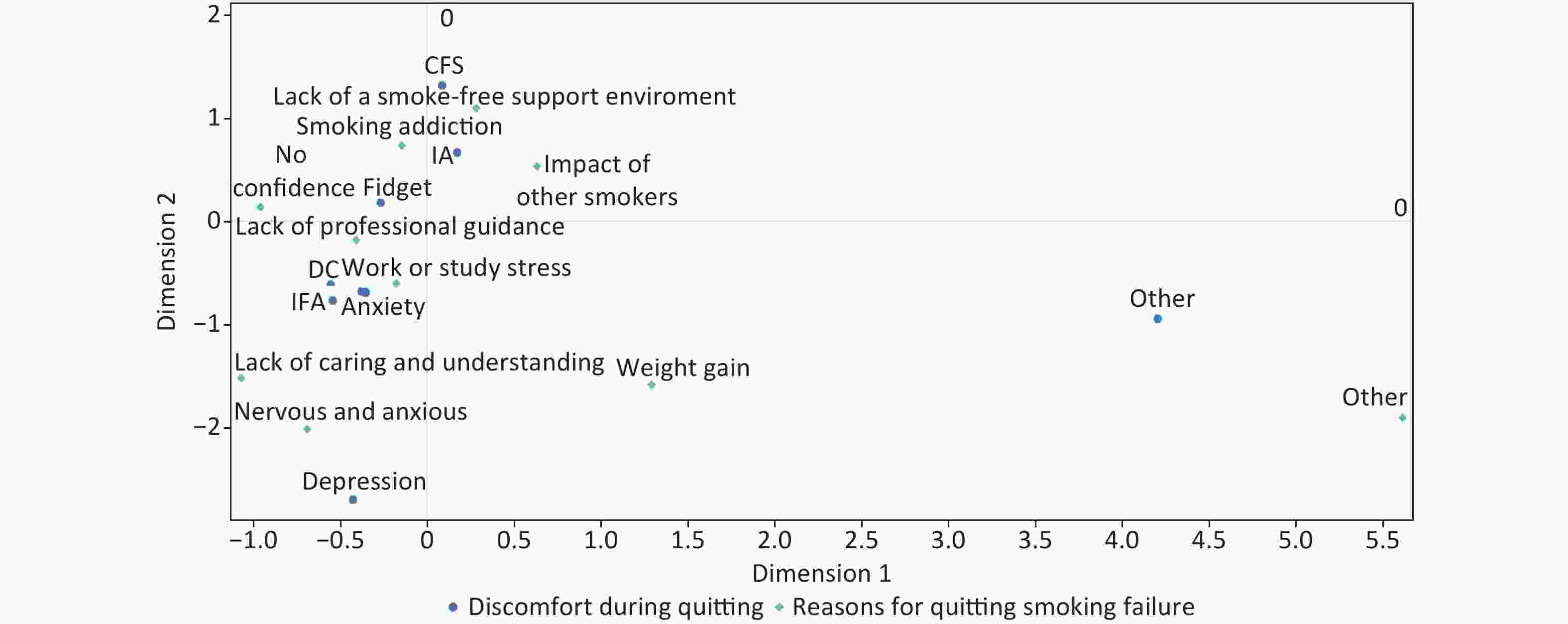
Figure 2. The relationship between failure reasons and discomfort caused by the smoking cessation in Beijing community smokers. Smoking addiction refers to difficulty to control the onset of smoking addiction, insufficient self-willing; CFS refers to a craving for smoking; IFA refers to irritability, frustration, or anger; DC refers to difficulty concentrating; SD refers to sleep disorder; IA refers to increased appetite.
In the correspondence analysis results, the reasons for failure to quit smoking in different occupational groups also differed. Smokers engaged in business services believe that the reasons for their re-smoking are mostly lack of professional guidance to quit smoking. Smokers who work in institutions or enterprises and professional skill work fail to quit smoking primarily because of lack of smoke-free support environment and tension, anxiety, mood depressed emotional effects, as seen in Figures 2 and 3. In this study, the survey respondents generally have a high level of education and may face the intensity of work that they can overcome daily. Some studies have pointed out that when quitters are physically tired or need to be highly concentrated at work, quitters will relapse because of stimulating demand[10]. In response to this situation, other alternative methods can relax the mind and body and shift the demand for tobacco. This also reminds us that we can start from workplaces to provide group health education and smoking cessation services for different groups of people with different occupations and occupational characteristics. Smoking cessation services can be personalized according to the characteristics of different occupations and the high incidence of failure reasons. The main reasons for relapse among retired smokers are difficulty controlling the onset of addiction, insufficient self-will, the influence of other smokers, and lack of confidence. After retirement, smokers have a relatively leisurely life, and they can find other hobbies in daily life to replace smoking. In addition, from a family and community perspective, a smoke-free support environment can be shaped, and family members help monitor smoking cessation and often give encouragement to improve smokers’ confidence and determination to quit.
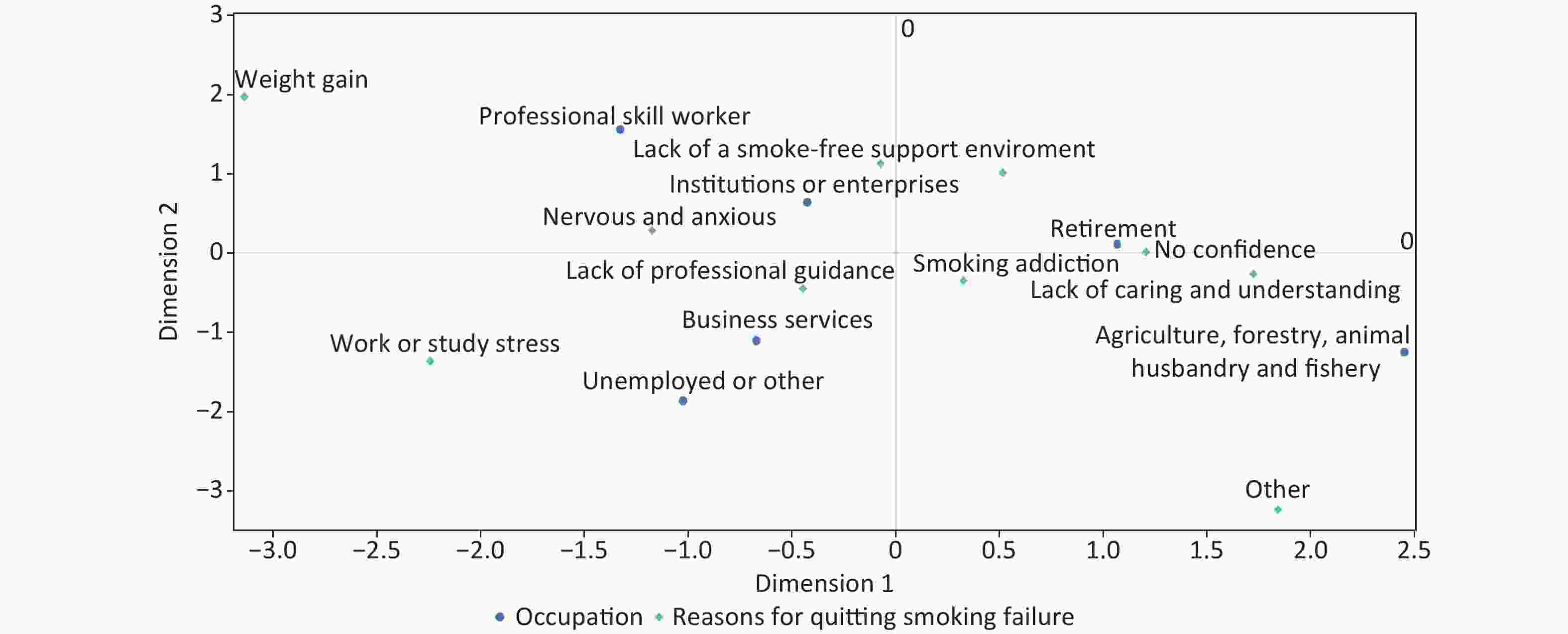
Figure 3. The relationship between the causes of failure of smokers in Beijing communities and their occupations. Smoking addiction refers to difficulty to control the onset of smoking addiction, insufficient self-willing.
In summary, work or study pressure, the influence of other smokers, and the lack of a smoke-free support environment are the main reasons for the failure of smoking cessation attempts. Therefore, it is recommended to strengthen education in different occupational places and implement personalized smoking cessation education. In addition, it is also recommended to provide tips on coping with smoking cessation and relieving peers in social situations, as well as help for coping with stress and negative emotions, to help smokers relieve discomfort during smoking cessation and increase confidence and determination to quit successfully.
No potential conflicts of interest were disclosed.
We appreciate all investigators who participated in this study. We thank the staff from the 19 communities who cooperated with us in recruiting people to quit smoking, provided us with a venue to conduct our research, coordinated the timing of our study, and helped us compile information about the participants. We thank Tobacco Medicine and Tobacco Cessation Centre at the China-Japan Friendship Hospital for all the assistance and support during the research.
JIN Qian Ying was responsible for the conception and design of the study, data collation and analysis, literature/data collection, and the transcription of the article. LIU Han and MA Han Qiao were responsible for the preliminary field investigation and data recovery and review. QIAO Kun was responsible for the preliminary investigation and later data verification. Ali Akbar was responsible for proofreading the Chinese and English parts of this article. LI Xing Ming was responsible for the quality control and review of the article and responsible for the overall management and supervision of the study.
HTML
 Supplementary Materials21141.pdf
Supplementary Materials21141.pdf
|

|





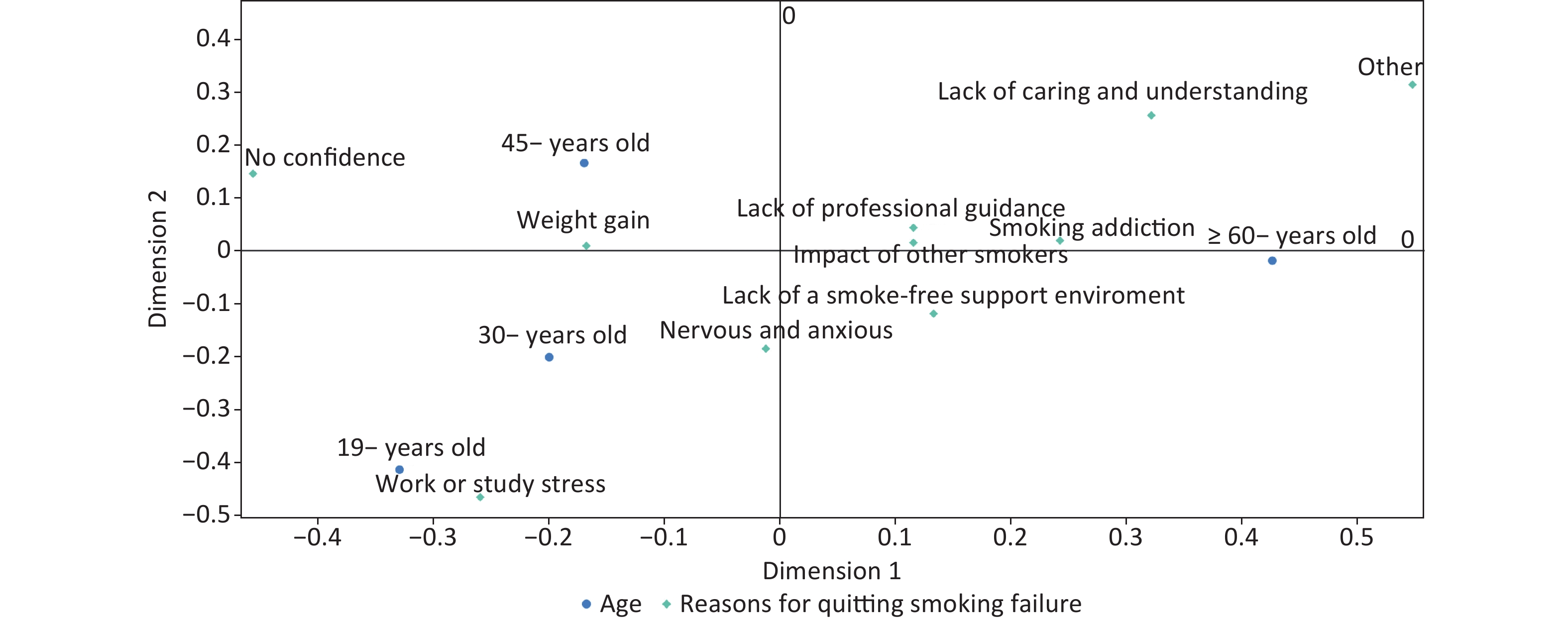


 Quick Links
Quick Links
 DownLoad:
DownLoad:
